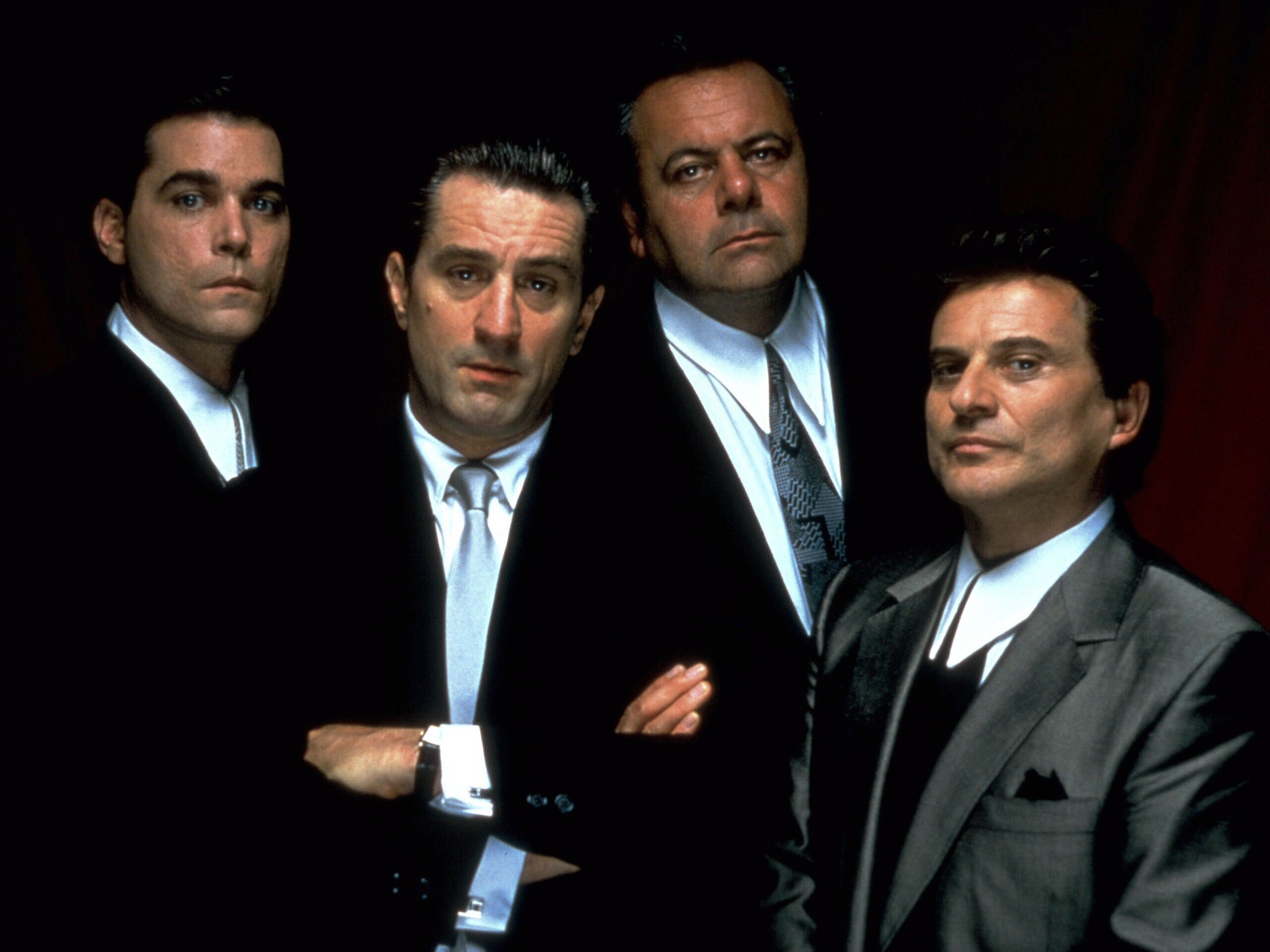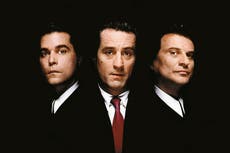How Goodfellas and the class of 1990 changed gangster films forever
To cinephiles long in thrall to ‘The Godfather’, there were clear rules as to how mob movies should be made. But then came a sudden and spectacular evolution in the genre, one that would leave Francis Ford Coppola’s third instalment lagging, writes Jason Bailey

As far back as I can remember, I always wanted to be a gangster,” Henry Hill (Ray Liotta) muses near the start of Goodfellas, and in the autumn of 1990, when that film was released, it seemed that every filmmaker of note wanted to make a gangster movie. Martin Scorsese’s Goodfellas led the way that September, with Phil Joanou’s State of Grace and Abel Ferrara’s King of New York opening later that month. The Coen brothers’ Miller’s Crossing followed in October. And in December came what was expected to be the biggest title of them all: The Godfather: Part III, the long-awaited follow-up to the Francis Ford Coppola films that most audiences considered the gold standard of gangster pictures.
Such a wave of similarly minded movies hadn’t been seen since the glut of rip-offs that followed the release of the original Godfather. The torturous time and effort required of any major production made their rollouts more coincidental than coordinated, although it seems safe to surmise that studios were hoping to ride the wave of interest in Godfather III. Yet that film, the most hotly anticipated and (initially) the most financially successful, was the least enthusiastically received – and left the smallest cultural footprint.
Instead, the other gangster movies of that fateful fall 30 years ago would prove far more influential: they combined to draw a map of the routes the crime movie, and movies in general, would take in the coming decade.
None made their mark more than Goodfellas, drawn from Nicholas Pileggi’s book Wiseguy and based on the real-life exploits of the New York mob underling-turned-informant Henry Hill. Scorsese was 47 when it was released, but he infused the picture with the furious energy and stylistic razzle-dazzle of a film school kid: elaborate camera movements, snazzy freeze frames, hard-boiled voice-over, non-chronological storytelling and tighter needle drops than a downtown DJ set.
The filmmaking is intoxicating because it makes Hill’s life of crime seem so seductive; it draws us into his world. So Scorsese crafts a subjective experience, often literally: in the shot introducing the various gangsters and hangers-on, all of whom speak directly into the camera (“I’m gonna go get the papers, get the papers”), or the notorious “May 11, 1980” sequence, which uses jagged cutting, jittery camerawork and battling music cues to put us directly into the head of the film’s coked-out, paranoid protagonist. Compared with the respectful distance of earlier gangster stories (even the Godfather movies), the immediacy of Goodfellas feels like an earthquake.
It left unmistakable fingerprints on some of the most important films and television shows to follow. “Boogie Nights is very much Goodfellas,” says Glenn Kenny, author of the new book Made Men: The Story of Goodfellas, who has also written for The New York Times. He also sees a clear connection to Quentin Tarantino’s Pulp Fiction and Reservoir Dogs – particularly the recurring motif of gangsters who hang out, talk trash and do their jobs like, well, jobs. Most gangster movies focus on the big bosses and godfathers; Goodfellas and its descendants are about the grinders, the middlemen, the working-class thugs.
Kenny also pinpoints the notion of “mobsters having other aspects of their lives,” everyday marital and familial woes, a key ingredient in David Chase’s subsequent groundbreaking series, The Sopranos. Chase has called the film “his Quran, so to speak”, drawing not only from the film’s tone and perspective for The Sopranos but also from its cast, which features several future Sopranos co-stars.
The hoods in State of Grace are, if anything, even smaller-time, expending their energies on nowhere hustles, petty theft and extortion. Foot soldiers for the Irish mob in Hell’s Kitchen, they’re scrappy street guys, and the relationship at the film’s centre is a direct descendant of Scorsese’s 1974 film Mean Streets; both pair a sensible, centred earner (Sean Penn here, Harvey Keitel in Mean Streets) with a dangerous, trigger-happy yet charismatic hothead (Gary Oldman, standing in for Robert De Niro). That dynamic would reappear in many an indie Nineties crime movie (most notably Nick Gomez’s Laws of Gravity), while the ethnic and geographic sensibility of State of Grace is a clear influence on Little Odessa and The Yards, the early crime films of director James Gray.
Coppola’s film was true to itself, and the artful approach to a disreputable genre that had made the series seem, 18 years earlier, so revolutionary
State of Grace is also noteworthy for its acknowledgement of the separation (and tension) between the Irish and Italian mob, expanding the insular Italian perspective typical of gangster narratives. Abel Ferrara would go even further in King of New York, which is in many ways a direct throwback to the traditional gangster movies of the 1930s, featuring a charismatic lead (Christopher Walken), a colourful cast of supporting players and a heady serving of social issues.
But King broke radically from norms in its racial makeup (its cast included future Nineties breakout stars Wesley Snipes, Laurence Fishburne and Giancarlo Esposito). Walken’s underworld boss Frank White is, in fact, white, but his crew is mostly black. Post-Godfather “blaxploitation” movies like Larry Cohen’s Black Caesar were as strictly segregated as their mainstream counterparts, but here, Ferrara not only integrates the milieu but casts the film’s old world Godfather-style Italian gangsters as outright relics, barriers for his forward-glancing criminals to remove quickly and efficiently.
A video store favourite, King of New York would have a profound influence on Nineties hip-hop culture (The Notorious B.I.G. frequently referred to himself as “the Black Frank White”); it would also serve as the template for several black-led gangster movies of the decade, including New Jack City and Sugar Hill (both fronted by King co-star Snipes).
Like The Godfather, Joel and Ethan Coen’s Miller’s Crossing begins with a portly, moustachioed man asking a mob boss for a favour. But Miller’s is a beast of its own, filtering the conventions of the gangster picture through the Coens’ distinctive sensibility, and it’s full of their trademarks: ornate, flourish-filled dialogue delivered at a mile a minute; complex, often dizzying plotting; exhilarating camerawork; bellowing overweight men; John Turturro.
“The tentative title for Miller’s Crossing was ‘The Big Head’,” Adam Nayman, author of The Coen Brothers: This Book Really Ties the Films Together, explains by email. “Other crime films have higher body counts, but I’d wager there aren’t many with as much discussion about the intricacies of introducing a bullet into the brain.”
The framing, staging and setting of a warehouse rough-up sequence are obvious prototypes for the notorious torture sequence in Reservoir Dogs, while a bloody shootout to the strains of “Danny Boy” lays the groundwork for the continuing convention of violence paired with incongruent musical accompaniment. “Amidst all the stylised dialogue, contrapuntal music cues and deadpan-character-actor-casting,” Nayman notes, “Quentin Tarantino (and his imitators) were taking scrupulous notes.”
By the time The Godfather: Part III finally arrived on Christmas Day, critics and audiences may well have simply burnt out on gangster movies. “At the time, it was a massive, massive, massive disappointment,” Kenny recalls, and it’s easy to see why (without even revisiting Coppola’s decision to cast his daughter Sofia, an acting novice, in a key role). It’s a decidedly old-fashioned movie, steeped in the classical style of its predecessors, laying out its story of gang wars, political wrangling, Vatican intrigue and personal redemption in studiously paced (sometimes pokey, even), exposition-heavy dialogue scenes.
To its credit, Godfather III is also quiet, introspective and emotional in a way that its flashy brethren aren’t. (Michael’s weeping confession of ordering Fredo’s death is one of the most wrenching scenes in the entire trilogy.) But by the time the picture landed at the end of that pivotal year, it seemed downright quaint. Coppola’s film was true to itself, and the artful approach to a disreputable genre that had made the series seem, 18 years earlier, so revolutionary. But by its third instalment, the Godfather series had served its purpose; the gangster movie had evolved yet again, into something even more grimy, eccentric and alive.
© The New York Times
Join our commenting forum
Join thought-provoking conversations, follow other Independent readers and see their replies
Comments



Bookmark popover
Removed from bookmarks